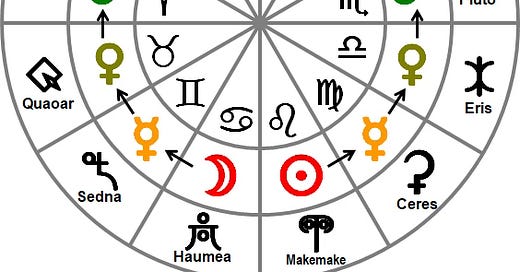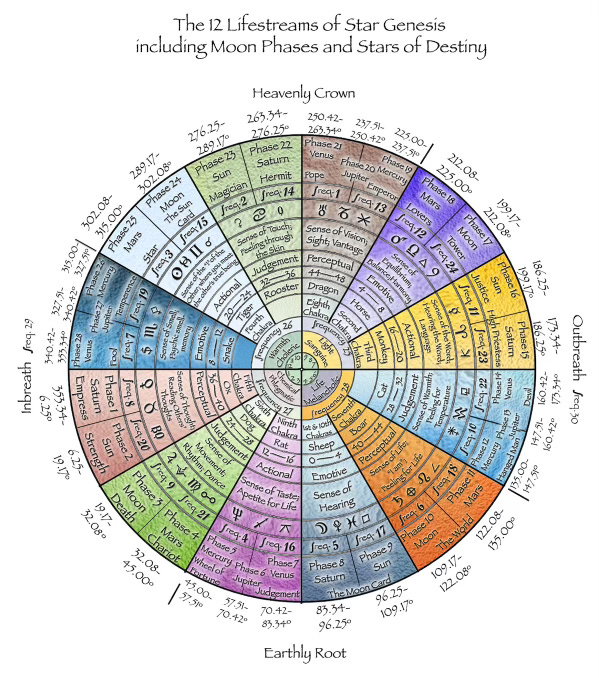A recent Facebook post included a graphic showing the traditional sign rulerships together with a set of supposed modern rulerships. Predictably, a lengthy discussion ensued, with passionate advocates for and against a variety of rulership systems, ancient and modern.
The graphic was by Walter Pullen, creator of the freeware Astrolog program. One of his interests is esoteric astrology in the Theosophical Society tradition of Alice Bailey and the Tibetan Master Djwal Khul. Personally, I’ve never been sold on the Theosophists, despite (or maybe because of) an early encounter with an esoteric astrologer who wrote a book on the subject.
Another recent Facebook post aimed to identify a list of esoteric astrologers, defined more broadly. Ellias Lonsdale wasn’t among them, but I think perhaps he should have been as his Star Genesis / Atlantean Astrology is certainly esoteric. As is much of John Sandbach’s work, with The Circular Temple, for instance, being distinctly alchemical in nature. Since most of us here are inspired by John & Ellias’s work, maybe we’re all esoteric astrologers too, of a sort.
Walter’s wheel
Walter’s graphic shows Uranus ruling Aquarius, Neptune ruling Pisces and Pluto ruling Scorpio. To be more precise, the graphic shows them as co-rulers of their respective signs, together with Saturn, Jupiter and Mars. So far, so good. Not that this widely accepted arrangement is entirely ideal, but generally speaking the three outer planet sign rulerships seem to work well enough for most modern astrologers.
I’m also drawn to Walter’s (and others’) idea of Eris as ruler of Libra. As Libran Ascendants can be prone to upsetting apple carts in order to put things back together again more harmoniously (as they see it), Eris and her golden apple seems quite a good fit.
The rest of Walter’s wheel is more contentious. I’m not at all sure about Ceres as ruler of Virgo. Co-rulership of Taurus might work, but for now I’m keeping an open mind. Chiron is missing entirely, presumably because of its diminutive size and confusing astronomical designation. But in any case, his maverick qualities might arguably disbar him from something as structural as sign co-rulership.
Walter suggests that the Earth co-rules Sagittarius with Jupiter, making a leap from the rulerships ascribed to Earth in esoteric astrology to Earth as a standard ruler of Sagittarius. This leaves me unconvinced.
The rest of Walter’s modern co-rulers are dwarf planets, namely Gonggong (Aries), Quaoar (Taurus), Sedna (Gemini), Haumea (Cancer), Makemake (Leo) and Orcus (Capricorn). I don’t know about you, but despite most of the dwarf planets being prominent in my chart I don’t yet feel much of a connection with any of them - apart from Ixion, but that’s another story.
Higher octaves
Alan Clay of Dwarf Planet University draws upon Dane Rudhyar’s ideas in promoting ‘higher octaves’ as a different way of thinking about the new planets.
Again, it’s satisfying enough to think of Uranus, Neptune and Pluto as higher octaves of Mercury, Venus and Mars respectively. But what about Sedna as higher octave of Ceres, and Ceres as higher octave of the Moon? Or Quaoar as higher octave of Jupiter, and Varuna as higher octave of Saturn?
Here’s Alan’s set of higher octave correspondences:
Sedna – Ceres – Moon
Makemake – Uranus – Mercury
Haumea – Neptune – Venus
Eris – Pluto – Mars
Quaoar – Jupiter
Varuna – Saturn
Some of this just doesn’t work for me. I don’t know much about the likes of Quaoar and Varuna, but Eris strikes me as more of an equal to Pluto, rather than a higher octave. And Ceres as higher octave of the Moon? Again, I’m not convinced. Perhaps I need to tune into the dwarf planets a bit more, but at present Alan Clay’s scheme seems a bit contrived, and I’m doubtful that Rudhyar would have supported it.
Pullen vs Clay
Comparing Walter Pullen’s co-rulerships to Alan Clay’s higher octaves, we find that Walter connects Makemake to the Sun and Alan connects it with Mercury and Uranus. Walter associates Haumea with the Moon, and Alan with Neptune and Venus. Walter says Sedna is a co-ruler with Mercury and Alan says it’s a higher octave of Ceres and the Moon. Walter connects Quaoar with Venus, and Alan connects it with Jupiter.
What are we to make of all this? Granted that sign rulerships and higher octaves are slightly different concepts, but you’d think there would be more similarities between them. It’s almost as if “anything goes”…and maybe it does.
If astrology is fundamentally a symbolic system, then arguably each of us may intuit and design a unique set of symbols, methods and techniques for analysing horoscopes that works for us, taking note of tradition and orthodoxy, but not being confined by it.
The Color Wheel
Which brings me to Ellias’s Color Wheel, in which the planet-sign correspondences seem to bear little or no relation to standard rulerships or affinities, making it a fascinating object for contemplation!
Almost everything about the Color Wheel is out of synch with common astrological thinking. The angles have more exotic names. The signs and houses are referred to as lifestreams, and are displayed in a different order—for instance, the first four lifestreams are associated with Taurus and Venus; Virgo, Jupiter & Vesta; Sagittarius and Neptune; and Pisces, Moon and Pluto.
At first glance, some of the associations are quite baffling, e.g. Leo, Earth and Saturn; and Capricorn with Uranus. Pallas Athena is the sole association with Scorpio, and Juno with Aquarius. Ponder on the Color Wheel too long and it can be crazy making!
There’s no doubting Ellias’s genius, but should we assume that the symbolism which works so well for him—and was largely given to him in a dream—will also work for us? For me, blindly following the Color Wheel makes no more sense than sticking rigidly to traditional orthodoxy. Instead, maybe we can draw upon Ellias’s inspiration and claim for ourselves the freedom to create our own sets of symbols, with the rulerships and higher octaves that make sense to us.
Or is this pushing the boundaries of astrology a step too far? Please feel free to comment.
In future articles I will consider what Dane Rudhyar had to say about rulerships and higher octaves. I will also examine his thoughts on planetary exaltations, which have a surprising connection to one of my favourite subjects: declinations.






Makes me think of the Collective Consciousness, enough of us agree to something, it becomes "true." But, does it really make it true? If we consider the ancients and add Neptune, Uranus and Pluto respectively, with age, they have become "tried and true" for most astrologers. Then, we had people like Ellias assign dwarf planets , astroids, planetary bodies of undesignated category in either co or solo rulership. Then more and more of said bodies came "on line." So my question would turn to, when do we stop? Who decides what newly seen PB we use as rulerships, or octaves and which ones do we pass on? I like that this was brought up as I do think about this from time to time. Well thought out.
Here’s a nice thought provoking article which incorporates classical and modern sign rulership with higher octaves, and has the alternating diurnal (day/masculine) and nocturnal (night/feminine) signs as a foundation:
https://timenomad.app/posts/astrology/philosophy/2018/10/05/how-classical-planets-rule-zodiac.html